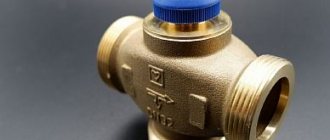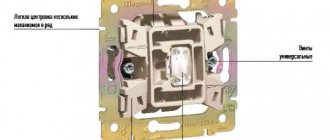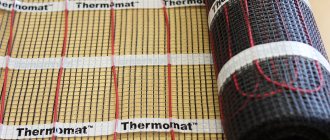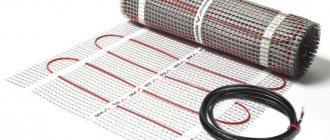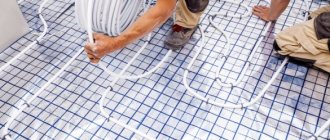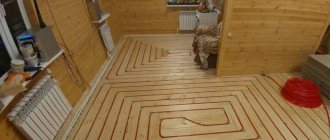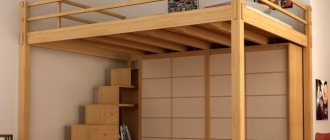We often try to make our task easier, to make the heating in our apartment as efficient as possible, while spending a minimum of money. It is this reason that forces us to look for alternative options for connecting heating circuits. The idea of using a boiler for a warm water floor is not ideal, however, this option has a right to life.
In this article we will look at what type of water heater is suitable for connecting a heated floor circuit to it, and how to recirculate hot water in the house.
Is it possible to connect a heated floor to a boiler or not?
When constructing water-heating floors, owners of apartments or private houses should:
- make a structure that will warm the air in the room to the required level;
- choose a profitable option in terms of installation and operation, which will be inexpensive.
First, we suggest that you learn the structure and operating principle of a water heated floor and the possibilities of combining the system with various devices (radiators, three- and two-way valves, etc.)
Gas or electric boilers are used to heat the coolant. More often, gas-fired boilers are installed in private buildings. It will not be possible to install such equipment in apartments with central heating.
In addition, to connect to a common heating system, you must obtain special permission. Therefore, there is a need to find an alternative method - this is the installation of an electric boiler.
Boiler is a device for heating water from electricity for domestic purposes. But it is worth noting that it was not originally intended to heat liquid for underfloor heating. Therefore, this will be an additional load for him, as a result of which the water heater may fail.
However, it is still possible to power the floor from a boiler, but it will not be possible to heat large areas using this method. This option is ideal only for the bathroom or toilet.
For your information! Correctly calculating the load on the electric heater is important.
The name of such a heating and cooling system
To be honest, I myself did not fully understand how to correctly name such a system in a nutshell.
Uponor calls these systems: Uponor Plaster - Universal system for walls and ceilings.
Rehau calls such systems: Rehau Rautherm S - Unified surface heating/cooling system.
If you think that warm walls are a new thing, then you are mistaken. During Soviet times, such systems were made. Recently, an acquaintance from Germany came to visit me; he lives in an apartment with warm walls. The apartment was built by Soviet builders about 40 years ago.
In Soviet plumbing books of the 80s, such a system was called a panel heating system. In our company, the name “warm walls” has stuck. First one client said so, then a second, a third, and it stuck. The name is not entirely correct, since everyone we installed pipes on their walls used for cooling.
By the way, both Uponor and Rehau produce ready-made panels with pipes built into them. True, due to high prices, such panels have never been ordered from us. But we install pipes on walls very often.
Types of boilers
A water heater is an electric boiler equipped with a tank in which heated liquid accumulates. For domestic purposes, designs up to 100 liters are used, and for industrial purposes up to 300 liters. An industrial type is recommended for installing floor heating.
By design, boilers are either instantaneous or storage.
Flow-through
Flow-through - a compact tank with a square-shaped ten, which is connected to a cold water supply. When turned on, the water heats up almost immediately. The power of such heaters is 6 - 10 kW, so they place a large load on the electrical network.
A tankless water heater is not suitable for heated floors.
Cumulative
A storage heater is a container with two casings, between which there is a protective layer of heat-insulating material (polyurethane foam). The outside body is enameled steel.
The inside of the flask has a coating of glass enamel; the process of its application is spraying, which allows you to obtain a smooth surface on which scale does not form. In addition, the enamel does not react to salts present in water and is not subject to corrosion.
Some models have an internal coating not of glass enamel, but of glass porcelain - the surface is of high quality, but if it is exposed to high temperatures for a long time, cracks can form. However, manufacturers guarantee that the device will operate uninterruptedly for at least 10 years.
Another type of coating that is used for boilers is stainless steel with titanium, which can withstand high temperatures. A water heater with such a coating will last for many years.
A heating element (in the form of a tubular heater) is placed inside the container; it heats the coolant. The ten is placed in a metal pipe, this protects it from scale. In addition, the flask contains a magnetic anode - a rod with positively charged particles that neutralize the negative charge.
This helps reduce corrosion formations. The rod needs periodic replacement, as it wears out quite quickly. The water heater is equipped with pipes through which cold water flows in and hot water comes out.
For your information! Today, models of electric water heaters with a volume of 250 - 300 liters have appeared on the market, which were specially designed for use in heating systems. Their difference is in the location and cross-sectional size of the supply and return openings.
The standard power of storage models is 1.5 - 3 kW. The device is similar to a thermos; the water is heated and then slowly cooled, thereby maintaining a high temperature for a long time.
In addition, these types have a thermostat, which allows you to set the heating temperature required for heated floors. And when the required temperature level is reached, the boiler automatically turns off, which contributes to rational energy consumption.
In shape, boilers can be horizontal or vertical. The vertical design is recommended for arranging heating floors.
It is important to know! To heat 15 liters of water to 60 degrees, you will need a heater with a power of 1 kW, heating time is 1 hour. A 100 liter tank will reach this level in 3 hours, with a power of 3 kW.
Device
The design of electric boilers largely depends on the type of design, so you should consider them in order:
- Boilers with heating elements as a heater. The heat exchanger, inside of which there is a heating element, when turned on, it begins to heat the water. In essence, the principle of a conventional boiler is used. The system is simple and most vulnerable from the point of view of many processes that destroy and weaken the functionality. With a high efficiency of the heating element, equal to almost 100%, over time, scale will inevitably form on it, which significantly reduces heat transfer. The service life of the heating element, declared by the manufacturers, is 10 thousand hours, which in itself is not very long, but in practice, not every heater reaches this value - the coil burns out. Heating elements cannot be repaired.
- An electrode boiler works on the principle of heating water between two electrodes under voltage. There is a container - a heat exchanger, inside which an electric current is passed through the water column from one contact to another. There is a saving of about 40% of energy, since there is no need to heat anything - the temperature of the water changes depending on the course of the physical process. The inconvenience is that only special compounds can be used as a coolant, which eliminates the possibility of heating household water.
- The induction type of heater is the most advanced and economical of all currently used types of electric boilers. There is an inductor. It plays the role of the primary winding. Secondary (like a short-circuited turn) - heat exchanger housing. When current is passed through the primary winding, the secondary winding is inducted, causing it to heat up and give off heat to the water inside. Since the heating area is maximum, the boiler’s operating efficiency is very high.
Operating principle of a water heater
The operating principle of an electric boiler is mixing cold and hot coolant. Heated water rises to the top, and cold water is located below, where it is heated.
The operating process of the water heater is as follows:
- The storage tank is filled with water through a special pipe. The inlet is equipped with a safety valve; it holds the liquid and does not allow it to flow back.
- The thermostat sets the required temperature, but not more than 80 degrees.
- The heater turns on automatically and water heating begins.
- The hot liquid rises upward and exits through the intake tube located on top of the tank.
- The coolant moves through the intake pipe into the floor pipeline.
Characteristics of gas models
Modern modifications of gas boilers must be equipped with electronic controls that regulate temperature parameters, ensuring the safe operation of the system.
In order for the automation and circular pump for a warm water floor to work in the event of a power outage, it is advisable to stock up on a local source. Car batteries will provide several hours of operation. In situations where there is a risk of frequent power outages for several days, you will have to purchase a diesel generator.
The principle of operation of the boiler is based on the circulation of the coolant through the exchanger, during which it is heated by the flue gases produced when the fuel burns. During the transfer of thermal energy, the gases are cooled, and at a certain temperature condensation is formed, causing the appearance of additional heat. This feature significantly increases the efficiency of heating equipment.
Gas boilers function flawlessly under conditions of uninterrupted gas supply, without requiring special routine maintenance techniques. In designs that provide an electronic mechanism for igniting the boiler, the operation of the burner is regulated in accordance with the specified temperature values with the removal of all harmful combustion products through forced ventilation. Boilers with piezo ignition, operating automatically, also stop the flow of gas if the flame goes out, but combustion is restored manually.
Which boiler to choose?
For the construction of warm water floors, the model of a flow-through electric boiler is practically not suitable. The main disadvantage is the significant energy consumption.
The only suitable option for heated floors is a storage water heater. When choosing the type of heater, attention should be paid to the power of the equipment; this determines how intensively and quickly the coolant is heated, as well as its volume.
For your information! Devices with a power of 6 - 10 kW are specially designed for installation in conjunction with heating systems. Their main disadvantage is their high electricity consumption.
When calculating the power of an electrical appliance, you should start from the fact that to heat an area of 10 square meters you need a water heater with a power of 1 kW, so a household boiler model is not suitable for heated floors. It can only be used for small rooms - a bath or toilet.
The second point that you need to pay attention to when purchasing is the volume of the tank. The greater the amount of hot coolant received, the less often the water heater will be turned on periodically, in order to help save resources.
Life time
The declared service life of the system is more than 50 years!
A logical question arises: where did this come from and how was it calculated? Most likely, the information was obtained based on the fact that any manufacturer of polymer materials (pipes) automatically provides 50 years of trouble-free operation for its products (subject to operating temperature).
What if there is a liquid leak or a malfunction of the thermostat? And this can easily happen due to a power surge.
What will your pipes turn into after uncontrolled heating?
That is, here initially you need to take into account several factors, and not just the material of manufacture and its factory service life.
Secondly, do not forget that there is a thermal expansion compensator inside the pipe. Who calculated how long he would work?
Thirdly, it is unknown how the chemical composition of the non-freezing liquid will affect the properties of the tube walls. The properties of the antifreeze itself also change over the years.
This means that it will have to be drained and refilled somehow. No one usually tells you about these nuances.
You just have to BELIEVE in the beautiful number 50.
Features of the design of a heated floor connected to a boiler
When designing a floor heating system from a boiler, you need to take into account:
- the size of the pipeline and the number of branches, the longer the circuit, the slower the fluid circulation will be;
- power of the heating element - if the size of the lower threshold of the heated room corresponds to the power of the boiler, then after some time the efficiency of heating the coolant may decrease; the solution is to buy a heater with a power reserve of 20%.
In addition, the system requires constant maintenance - periodic descaling of the storage tank and heater. This procedure will help keep underfloor heating pipes in good condition and increase their service life.
It is recommended to connect the boiler in a bathtub or room located close to the heated room.
And to increase the productivity of the device, the structure must be equipped with a circulation pump.
By observing all of the above points, you can build a hydrofloor that can provide heating for your apartment.
Choosing linoleum
Most users choose linoleum based on appearance. It’s hard to argue with this, since the appearance of the coating is very important; it largely determines the style and overall quality of the room’s design.
However, to install it on a warm floor, you need to choose the right type of linoleum. There are three categories of material:
domestic
semi-commercial
commercial
All types of linoleum are divided into two groups:
- homogeneous material . This is a single-layer linoleum, representing a homogeneous fabric;
- heterogeneous linoleum. It is a multilayer material consisting of a base, a substrate, a base layer, and an outer coating.
Homogeneous linoleum is thinner than heterogeneous. In addition, it has high thermal conductivity, which is of great importance for working with heated floors.
Experts recommend choosing homogeneous linoleum, since multilayer materials are too dependent on temperature conditions and can begin to delaminate.
In addition, there are varieties made from natural materials or polymers (PVC). Natural linoleum is called marmoleum; only original components of natural origin are involved in its production:
- jute base;
- resin;
- wood flour;
- limestone;
- linseed oil.
Artificial linoleum is made from PVC with the addition of plasticizers and various compensators (for example, to protect against thermal expansion or changes in the linear dimensions of the canvas).
There are other varieties:
alkyd or glyphthalic linoleum
nitrocellulose, or colloxin. Thin material without base. It has high performance qualities, but is highly flammable;
rubber linoleum (Relin). Double layer material. Does not tolerate heat well and is used mainly in public or office spaces.
Not all types of linoleum are suitable for laying on a warm floor. Experts recommend choosing homogeneous (baseless) linoleum with a thickness of 2-3 mm. At the same time, marmoleum is considered one of the best options, although it has a jute base.
In addition, it is necessary to choose specialized brands of linoleum. They must have a base with antistatic treatment. In addition, the material must maintain working properties when heated and not dry out, crack or change color. Linoleum, designed to work in conjunction with electric types of heated floors, has a special marking on the reverse side - a heated floor icon (snake with arrows). If there is no such designation, the buyer risks soon having significant problems with the floor covering.
Connection diagrams for heated floors and boilers
There are several schemes for connecting a heated floor to an indirect water heater. Let's look at the simplest ones:
- Using a three-way valve - the essence lies in the interaction of two circuits: a warm floor and a water heater. This valve distributes the coolant between them. It is controlled automatically using a thermostat on the heater. This system promotes rapid heating of water in the boiler, while it is possible to completely shut off the supply of hot water to the floor branches. And when the set temperature is reached, the valve is activated and the supply is resumed. This piping method is suitable for constant use of the boiler.
- With two forced circulation pumps - this option is recommended for intermittent, seasonal use of the device. One is placed on the supply pipe in front of the water heater, and the other on the floor contour.
A thermal relay is used to power the circulation pump, so it functions only when the temperature drops below normal. Heating accelerates, and forced circulation is turned on. In this scheme there is no three-way valve, and the connection is made using tees.
- Using a hydraulic arrow - this method is recommended for boilers with a volume of 200 liters or more, and with several heating branches. A system with a hydraulic distributor makes the circuit simpler, and there is no need to install pumps on each floor circuit. The hydraulic arrow ensures equal coolant pressure in all loops. However, it is difficult to make a harness with your own hands in this way without experience.
Scheme with pump-mixing unit
This scheme also applies to combined systems, when you have both radiators and heated floors at the same time.
However, here, instead of a 3-way valve, a more expensive pumping and mixing unit is used.
Specification of materials
In fact, the cooled return flow is also mixed into the main boiler feed here. But thanks to the balancing valve, cooled water can be mixed in in certain doses and given proportions.
This will ensure the precisely specified temperature of the coolant entering the TP tubes through the manifold.
This is the most effective and most comfortable scheme. The pumping and mixing unit itself can be assembled in various variations.
Depending on your needs and financial capabilities, the following components may be included:
Construction and connection of heated floors to the boiler
For clarity, let’s look at how to make a heated floor from a water heater, using the example of using a 3 kW heater to heat an area of 30 m2, with the installation of a three-way valve.
We will need a recirculating boiler with outlets to connect hoses for hot and cold water supply. The recommended diameter of the pipes is 2.6 centimeters. In addition, you should stock up on the tools that you will need in your work so as not to be distracted during the installation process.
The sequence of construction of hydrofloors from a water heater is as follows:
- Preparing the rough base - it should be leveled and cleared of debris.
- Installation of the collector unit - it must be mounted on the wall, or mounted in a specially equipped metal box.
- Taping damper tape around the perimeter of the room will help maintain the integrity of the concrete screed.
- Hydro and thermal insulation - polyethylene film can be used as a waterproofing material. The choice of thermal insulation material is huge, from ordinary polystyrene foam to polystyrene foam mats with bosses.
- Installation of the water circuit - these can be pipes made of copper, polyethylene or heat-resistant plastic. The heating elements are laid according to the planned pattern and with a set step. The pipes can be attached to the reinforcing mesh, which is laid on the thermal insulation, with plastic clamps, or fixed between the grooves of polystyrene plates.
- Connect the circuit to the distribution manifold - one end to the cold tap, and the other to the hot one.
- The boiler is connected to the distribution unit using metal pipes.
- Installation of a three-way valve with a thermal head on the manifold - to regulate the temperature level of a warm water floor.
- Connecting a circulation pump to a warm floor - it provides the flow and necessary pressure of water in the floor pipeline.
- Installation of an expansion tank - it is necessary to remove excess water from the heating system. It should be mounted on a cold metal pipe near the outlet to the boiler. And in front of it you need to equip a tube for air outlet.
- Checking the system for operability - to identify possible leaks and malfunctions. Pressure testing is carried out during the day under operating pressure.
- Filling the screed - the contour of the floor is poured with concrete mortar. The procedure is done when there is pressure in the pipes. The concrete layer must be allowed to dry thoroughly, this will take about a month.
- Laying the finishing coating - it is laid only on a completely dry concrete base.
You can turn on the water system only when the screed, as well as the tile adhesive if ceramic tiles were used as a floor covering, have dried. The temperature should be raised to operating condition gradually over several days.
The principle of operation of this circuit is to heat water in the tank, then it is discharged through the collector into the floor circuit. The waste coolant is returned through the distribution unit to the return pipeline.
If the water temperature exceeds the required level, the three-way valve automatically shuts off the hot water supply and opens the cold water supply. The mixing process is carried out in a special chamber. When the coolant reaches the desired degree of heating, the thermal head closes the flow of cold water.
The heater and collector are equipped with separate automatic devices for temperature regulation. The device on the collector is responsible for the coolant in the floor line, and on the shade - for the level of water heating.
You can install a heated floor from a boiler both in a house and in an apartment. Installation is not difficult, the main thing is to follow the technological process and instructions. In addition, the low cost of installation is of no small importance, because a water heater costs less than an electric boiler.
However, it should be noted that the operation of such a heating system is accompanied by high energy consumption. Therefore, it’s up to you to decide how to heat your home - with a regular radiator or underfloor heating from a boiler.
Better maintainability
One of the main advantages of the system is its good maintainability. If the cable fails, it can be replaced without any problems by simply pulling the old one out of the tube and pulling the new one in.
With a heating cable directly embedded in the screed, this trick will not work. In real conditions, the best maintainability of the system is “slightly” different.
Ask any electrician, can he replace a cable laid in a corrugation under the plaster?
The first question he will ask you is “How many turns will there be and at what angle?”
If there are more than three bends, then it will no longer be possible to do this. Now remember the snake that is used to lay heated floors.
How many roundings and turns can you count in an area of at least 10 m2, not to mention much larger sizes?
If you have an exclusive special machine with a pump (it changes the cable in the pipe due to the circulation of liquid under pressure), this can still be done.
But you won’t be able to replace it yourself with a dry one, without special tools. Problems will also arise if there is a hole in the pipe.
This is what a pipe burned through by a burnt cable looks like. The injected liquid will simply flow through it.
In addition, if there is a short circuit on a conventional heating cable, you can find this place of damage, locally open the floor and install a repair coupling there.
A cable immured in a pipe with liquid cannot be repaired locally. You will have to change the whole thing and pay for it in full.
Was the 84-meter-long circuit damaged in any specific place? Please buy these 84 meters again!
Add to this the likelihood of damage to the tube itself, separately from the cable (accidentally drilled or driven in a nail). As a result, additional detachable connections appear in the screed.
Do you think this is normal for further operation of the system?
So it turns out that reliability is noticeably reduced due to all these factors.
Even the vaunted repairability of pipes does not help when they are heated with a hairdryer. As the advertisement says, if any section is broken, just heat it with a hairdryer, and the tube wall will return to its original state.
In fact, in all the pictures, during such repairs, an empty pipe is heated, without coolant. Which means you have another headache.
How to drain and refill antifreeze while maintaining the factory sealing reliability of the entire heating system?
In addition, we can visually check how the tube wall has “restored” only from the outside. No one knows what is happening to her inside.
A decent manufacturer will not give you any guarantee after such a crease.

